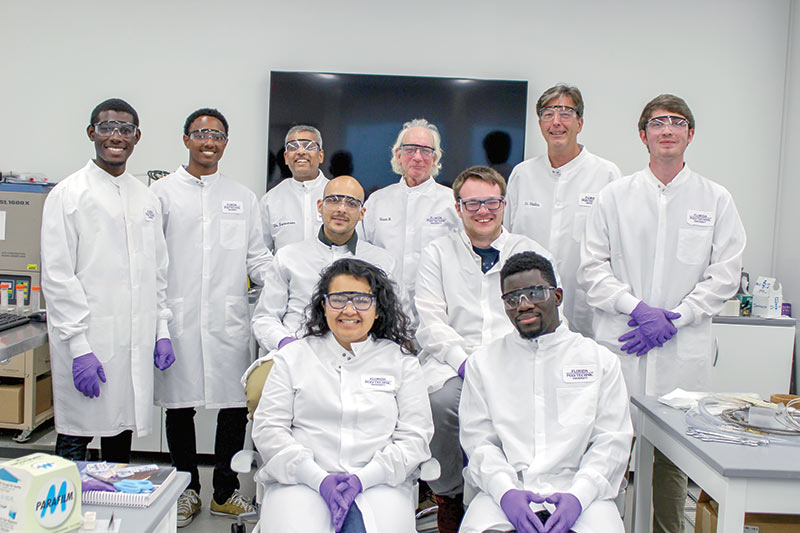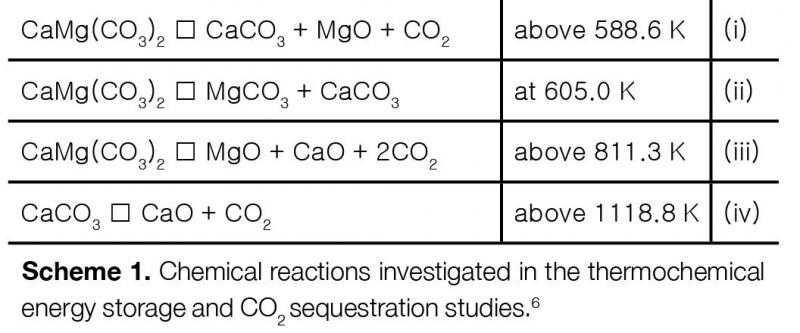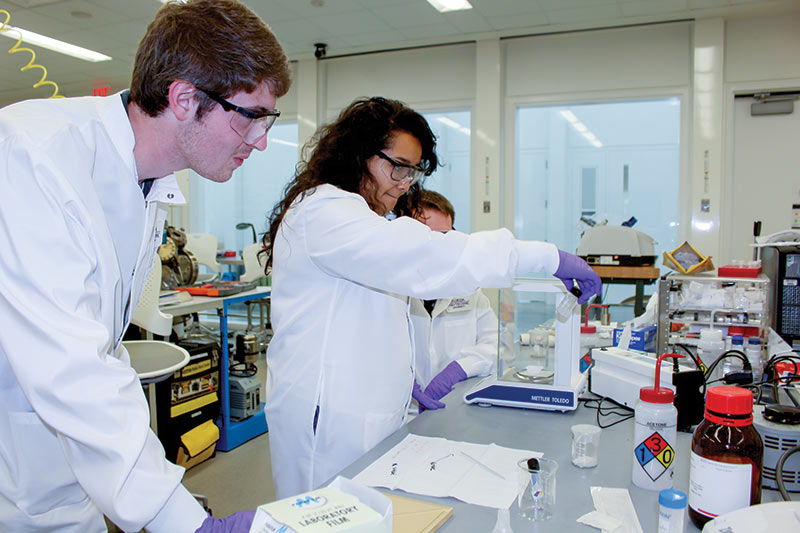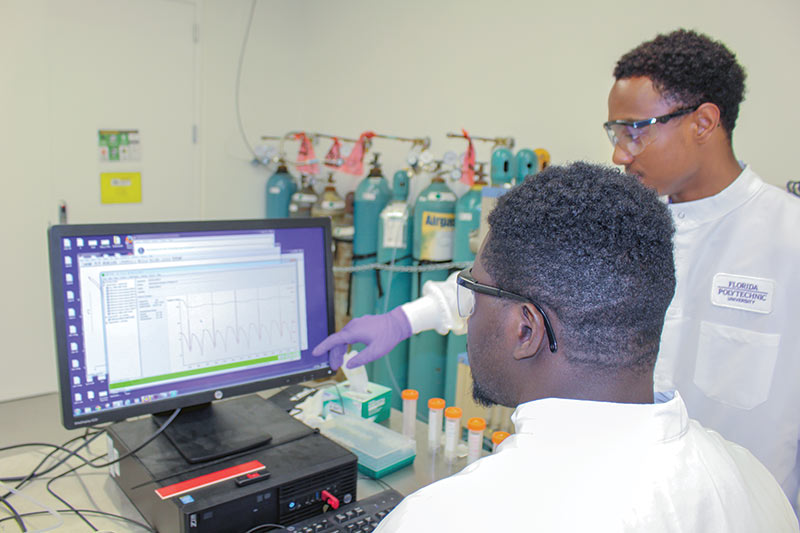Dolomites for Thermochemical Energy Storage and Carbon Capture
Spring
2019
Building Blocks - Undergraduate Research and Outreach Projects
Dolomites for Thermochemical Energy Storage and Carbon Capture
Dominic Dodson, Mc Ben Joe Charles, and Wyatt Liptak, SPS Members
Sesha Srinivasan, SPS Chapter Advisor
Scott L. Wallen and Gary Albarelli, Florida Polytechnic University
Florida supplies four million tons of phosphate, used primarily in fertilizer, every year—three-fourths of the phosphate used in the United States. In Polk and Hillsborough counties primarily, long dragline excavators scoop up phosphate-containing minerals mixed with clay and sand, then separate out the phosphate.1 The most uneconomical ingredient in the phosphate mineral matrix is the calcium-magnesium carbonates, CaMg(CO3)2, also known as dolomites. The mining industry routinely terminates the mining process when it encounters dolomites, or dolostones, which are a major source of magnesium and are not favorable for phosphate fertilizer processing. The dolomites are not only difficult to remove from the clay matrix but also pose “sustainability issues due to their deposition in clay settling ponds around these counties.” The magnitude of this problem will be multifold if future mining expands to other Florida counties such as Manatee, Hardee, and DeSoto.2, 3 
Dolomites contain magnesium, which is a major hindrance in the manufacturing of phosphoric acid for diammonium phosphate (DAP) fertilizer production. High magnesium content increases the sulfuric acid consumption and causes a lower yield of phosphoric acid.2, 3
High-temperature thermochemical energy storage utilizes reversible reactions that store energy in the chemical potential of the system. This type of energy storage process is thought to be critical for on-demand energy production and penetration of concentrated solar power into the grid. Current storage systems rely on molten salts, which have an operating temperature limit of 550°C, but concentrated solar power systems operate above 600°C.
A very recent publication by Kakosimos et al. studied the characterization of surface carbonates obtained from various regions of the Qatar peninsula that have shown promising potential for applications in CO2 capture and thermochemical energy storage.4 According to this report, dolomites have higher performance in terms of CO2 sorption and storage capacity when compared to calcite, CaCO3. In a long-term cyclic stability study, up to 27% thermal energy storage was demonstrated by Perlinger et al. in a groundwater aquifer, which was plausibly due to the presence of minerals (dolomites).5 Based on the aforementioned reports, the authors are conducting feasibility studies of high-dolomite phosphatic pebbles obtained from the Florida Industrial and Phosphate Research Institute for use in two sustainable and green technological applications: (i) for thermochemical energy storage in concentrated solar power plants, and (ii) related to carbon dioxide capture and sequestration at fossil-fuel-based power plants.
Our team is examining the thermodynamic and kinetic parameters important to the chemical reactions involved in these two applications, as shown in Scheme 1 below:
Thermogravimetric analysis (TGA) accurately measures changes in mass as a function of some perturbation such as temperature, chemical reaction, or even adsorption. The dolomite-containing samples are subjected to temperatures that enable the endothermic calcination [Scheme 1(iii)] and then subsequent exposure to a CO2 atmosphere, readsorbing CO2 to undergo the reverse exothermic carbonation reaction, giving off energy. These reversible reactions are then performed over and over to determine the cyclic stability of the dolomite-containing systems. Following the mass changes allows us to examine what portion of the original sample is able to react in a continuous cycle, which is important information in developing a process for the thermochemical energy storage (TCES) and CO2 sequestration using dolomite mineral resources. At various stages in the process, the dolomite phosphatic rock was analyzed for its constituent minerals using energy-dispersive x-ray spectroscopy (EDS), x-ray fluorescence (XRF), and x-ray diffraction (XRD), as well as examination of the development and closing of pores important for CO2 diffusion and necessary for the reactions using scanning electron microscopy (SEM).
The first and foremost challenge we overcame during this research was figuring out how to execute the calcination-carbonation looping cycles. We have figured this out by optimizing our TGA methods and procedures. Our next setback was successful operation of calcination and carbonation processes in high-pressure and high-temperature setups, in which we used a hydrothermal Parr reactor and tube furnace attached with a CO2 gas line. To make sure the experimental environment stayed consistent for each of the calcination and carbonation runs, we had to be very careful and attentive in TGA measurements to not cause any disturbance.
The students who worked on this research project received hands-on training for each of the tools and analytical instruments. Literature searches, given as assignments, improved their skill at finding articles on Science Direct and other electronic sources. By the end of the project, each student had learned and understood the underlying physics, chemistry, and engineering applications of dolomites for thermochemical energy storage and carbon capture.
We are continuing to tune our optimization processes and hope that the addition of other impurities such as a few mole concentrations of alkali halides (for example, NaBr or LiBr) will improve the calcination-carbonation loop cycle performance in terms of rate kinetics and thermodynamics, our next step toward discovering a solution to our world’s clean energy storage and carbon sequestration dilemma.
This project was funded via the SPS Chapter Research Award and Florida Industrial and Phosphate Research (FIPR) Institute. Faculty and staff advisors Dr. Sesha Srinivasan, Dr. Scott L. Wallen, and Mr. Gary Albarelli oversaw this research.
Florida Polytechnic University’s provost Dr. Terry Parker, as well as professors Dr. Nicoleta Hickman, Dr. Robert Green, Dr. Mary Vollaro, and Dr. Richard Matyi, are gratefully acknowledged for their support in terms of instrumentation accessibility and other infrastructural support. We would also like to acknowledge the comments and suggestions of Dr. Jaspreet Dhau from Molekule, Inc.


References:
1. C. Pittman, The Clock is Ticking on Florida’s Mountains of Hazardous Phosphate Waste, April 2017, https://www.sarasotamagazine.com/articles/2017/4/26/florida-phosphate.
2. Five Year (2011–2016) Strategic Plan of Florida Industrial and Phosphate Research Institute (FIPR Institute), 48 pages, February 2011, updated May 2014.
3. ITP Mining: Energy and Environmental Profile of the U.S. Mining Industry, Chapter 8: Phosphates, pages 8-1 to 8-16, December 2002.
4. K. E. Kakosimos, G. Al-Haddad, K. G. Sakellariou, C. Pagkoura, A. G. Konstandopoulos, Characterization of Qatar’s surface carbonates for CO2 capture and thermochemical energy storage, AIP Conference Proceedings, 1850, 090003 (pages 1–6), 2017.
5. J. A. Perlinger, J. E. Almendinger, N. R. Urban, S. J. Eisenreich, Groundwater Geochemistry of Aquifer Thermal Energy Storage: Long-Term Test Cycle, Water Resources Research, 23, 12, pages 2215–26, 1987.
6. Olszak-Humienik, M. Jablonski, Thermal Behavior of Natural Dolomite, Journal of Thermal Analysis and Calorimetry, 119, 3, pages 2239-2248, 2015.
Dig Deeper
Read all about the Florida Polytechnic University team’s project at spsnational.org/awards/sps-chapter-research-award/2018/florida-polytechnic-university.
Interested in starting a research project of your own?
Learn more about the SPS Chapter Research Awards and how to apply at spsnational.org/awards/chapter-research.
More from this department
Building Blocks - Undergraduate Research and Outreach Projects
